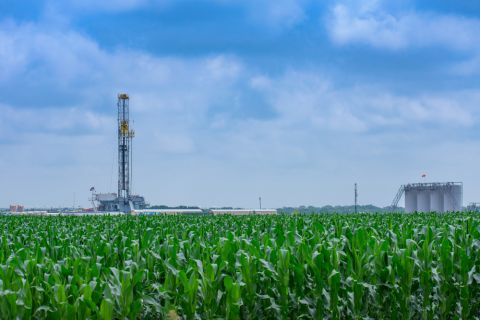Despite industry complexity and non-linearity, now’s the time to think about the future, says former Chevron CTO With a credit crisis, global recession, and depressed petroleum prices looming over the heads of the 500-plus attendees at the recent Microsoft Energy Forum, keynote speaker Don Paul, founder and president of Energy and Technology Strategies, took a shot at putting things in perspective. “Today, everyone is focused on managing the business tightly. But five years ago the price of crude oil ranged from $32 to $35 a barrel. A year ago the flavor of things was different. You may have had the resources to hand. But in some ways, with everyone scrambling, it was a more difficult environment.” Paul is the former vice president and chief technology officer for the Chevron Corporation, retiring in 2008 after 33 years of service. In 1999, he formed Chevron Technology Ventures, Chevron’s venture capital investment subsidiary. Dr. Paul has been a member of the National Research Council, the 1997 Presidential Panel on Federal Energy R&D; and the 2007 landmark study by the National Petroleum Council for the US secretary of energy. “Upstream has a long time horizon,” said Paul, “and it’s important to keep a clear perspective. Oil and gas remains the predominant energy source, but the context is changing. During the slow-down may be the best time to think about the future.” As Paul pointed out, price volatility in the petroleum industry isn’t a recent phenomenon and the “nonlinearity” characteristic of the oil industry is evident in the almost complete failure of a great number of experts to predict oil prices accurately. “Swings of 50% average value are common,” he said. “If you look at the forecasts for 2010, the view ranges from $30 to $120 dollars a barrel. My own answer when asked is to say the price will be $120, plus or minus $60.” Complex complexity Equally characteristic of the industry is its complexity, involving a welter of technology, business, political, and economic factors. The interactions of competing interests drive things, said Paul. “Look at the way the information-technology industry supported President Obama’s election; but that wasn’t the view of the oil & gas industry. The new administration is focused on energy policy, but it doesn’t necessarily have the same agenda as those gathered here today. We need to recognize, however, that there are clear intercepts. The government needs to bring the traditional energy industry along with it. And the bridge is technology.” Technology has been at the core of the petroleum industry from when it was first realized the subsurface could be accessed by drilling, said Paul. “But it’s not the decisive factor. Besides business and economics, politics and policy matter too, and the industry hasn’t always understood that.” Carbon regulation, either in the form of a carbon tax or a cap-and-trade policy, is coming, said Paul, but “it’s difficult at this point to see how it will manifest itself.” His personal preference would be to see a carbon tax because, like a value-added tax, or VAT, popular in Europe, it impacts every level of the supply and demand chain. However, he thinks cap-and-trade the more likely outcome. Moreover, the long-term trends governing energy demand are not being driven by the developed economies. Population growth and economic growth, beginning in the early 1990s, has been driven by developing countries and, as a result, will continue to drive energy-demand growth. “How our industry, the most important source for fuel, responds to this will be determined by our ability to conceive an infrastructure that responds,” Paul said. One aspect of meeting the supply challenge involves effectively managing the existing production base. “Ultimately you will see a decline in reserves and output that has to be taken into account by the system,” said Paul. “By 2015, we will need to make up 30-plus million barrels. There are projects on the book for that. But by 2030 we will have to replace an amount equal to what we produce today, 70 million barrels. It will take a significant tranche of unconventional and bio fuel sources to achieve that.” At the same time, Paul isn’t a devotee of peak oil theories. “We’re not running out of molecules, but the challenge of bringing them to production will be significant.” The digital revolution Paul next addressed the industry’s somewhat ambivalent attitude toward new technologies. “We will see unabated increases in digital intensity and the application of Moore’s Law” he said. “The recently announced investments by Intel are encouraging in this regard. There are two aspects to managing the digital tidal wave: its sheer information volume and the challenge of getting to the data needed for decision making.” The work organization and structural changes following from the digital revolution are part and parcel of the generational change going on in the industry. “While the generational transition may slow during the downturn it will continue and represents a significant challenge,” Paul said. Paradoxically, while the oil & gas industry is at the forefront for technology advances in supercomputing, materials research, and in a number of other areas, it has a reputation as being slow to adapt new technologies. Paul alluded to this fact when he asked: “What’s keeping oil and gas industry from adopting more advanced technologies?” His take on the matter is that with the industry’s long-term perspective, it waits until it has near complete confidence before widely deploying them. “We need to understand how they will be maintained despite disruption. Some of the hesitation is generational as well. The new generation recognizes value, but there is an adjustment period, and oil companies want to understand what a change will mean.” In conclusion, while Paul hesitated to say that companies will increase information-technology spending amidst the downturn he does believe they need to leverage today’s infrastructure to increase productivity. “You might devote intellectual resources to optimizing the existing resources and think through how you can implement Information infrastructures that will allow more efficient processes when the upturn comes again.”
Recommended Reading
NextEra Energy Dials Up Solar as Power Demand Grows
2024-04-23 - NextEra’s renewable energy arm added about 2,765 megawatts to its backlog in first-quarter 2024, marking its second-best quarter for renewables — and the best for solar and storage origination.
Halliburton’s Low-key M&A Strategy Remains Unchanged
2024-04-23 - Halliburton CEO Jeff Miller says expected organic growth generates more shareholder value than following consolidation trends, such as chief rival SLB’s plans to buy ChampionX.
Enverus: Q1 Upstream Deals Hit $51B, But Consolidation is Slowing
2024-04-23 - Oil and gas dealmaking continued at a high clip in the first quarter, especially in the Permian Basin. But a thinning list of potential takeout targets, and an invigorated Federal Trade Commission, are chilling the red-hot M&A market.
Baker Hughes Awarded Saudi Pipeline Technology Contract
2024-04-23 - Baker Hughes will supply centrifugal compressors for Saudi Arabia’s new pipeline system, which aims to increase gas distribution across the kingdom and reduce carbon emissions
Ithaca Energy to Buy Eni's UK Assets in $938MM North Sea Deal
2024-04-23 - Eni, one of Italy's biggest energy companies, will transfer its U.K. business in exchange for 38.5% of Ithaca's share capital, while the existing Ithaca Energy shareholders will own the remaining 61.5% of the combined group.




